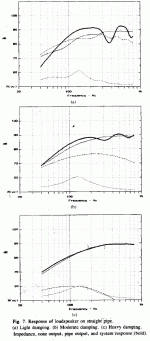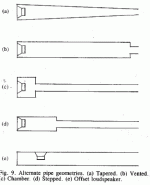I intend to use a Jordan JX92s in a transmission line together with an ESg-1 using an active crossover. (I estimate that I only need a 1.5W ESg-1 amplifier to match a 40W JX92s amplifier.)
I've printed out the JX92/ESg-2 thread and the "Simple and Enjoyable" thread using the Jordan JX92 in a transmission line. I'm well aware that Ted Jordan offers a T/L design, but I don't like wide, shallow speakers because they look ugly (to my eyes), they can wobble in the direction of cone motion, and the wide baffle makes diffraction more of a problem. Exit Ted Jordan's design. Apart from my existing (rather larger) T/L loudspeakers, I built one for a KEF B110 when I was a kid that all my friends admired, but I never quite got the peaks and dips out of it (I've since been able to measure it). As a consequence, I believe it's important to position the driver so as to suppress the 3rd harmonic, so simulation is a must. I've downloaded Martin King's MathCad sheets, but the downloaded MathCad refused to install. Many people seem to have talked about JX92 in a transmission line, but the Tidy T/L doesn't appear to consider the 3rd harmonic problem.
My ideal design would have:
Transmission line with consideration given to 3rd harmonic (and higher) problems.
Narrow baffle (to minimise diffraction problems).
Deep box (to minimise rocking due to driver excursion).
High SPLs and thunderous bass are not requirements. Clarity, accuracy, and delicacy, are.
Crossover design is not an issue. I'm quite happy to spend time trying different designs, measuring and listening. Acoustical design is the problem. Do I need to buy MathCad and start from scratch using Martin King's model, or is that reinventing the wheel?
I've printed out the JX92/ESg-2 thread and the "Simple and Enjoyable" thread using the Jordan JX92 in a transmission line. I'm well aware that Ted Jordan offers a T/L design, but I don't like wide, shallow speakers because they look ugly (to my eyes), they can wobble in the direction of cone motion, and the wide baffle makes diffraction more of a problem. Exit Ted Jordan's design. Apart from my existing (rather larger) T/L loudspeakers, I built one for a KEF B110 when I was a kid that all my friends admired, but I never quite got the peaks and dips out of it (I've since been able to measure it). As a consequence, I believe it's important to position the driver so as to suppress the 3rd harmonic, so simulation is a must. I've downloaded Martin King's MathCad sheets, but the downloaded MathCad refused to install. Many people seem to have talked about JX92 in a transmission line, but the Tidy T/L doesn't appear to consider the 3rd harmonic problem.
My ideal design would have:
Transmission line with consideration given to 3rd harmonic (and higher) problems.
Narrow baffle (to minimise diffraction problems).
Deep box (to minimise rocking due to driver excursion).
High SPLs and thunderous bass are not requirements. Clarity, accuracy, and delicacy, are.
Crossover design is not an issue. I'm quite happy to spend time trying different designs, measuring and listening. Acoustical design is the problem. Do I need to buy MathCad and start from scratch using Martin King's model, or is that reinventing the wheel?
What I've done...
Hi EC8010,
I made a TL for the JX92S which is different than the Jordan version, which has a deep profile. The enclosure is pretty flexible so I can design into it whatever internal baffling that I want, so I'll play with a couple different approaches. One is a 'U' shape with the vent at the top at the back and a second one is an alternating design with a vent down at the floor (or on the bottom)
Some initial testing has shown the output from the pipe to begin falling off fairly well around 100 to 150 Hz. I'm sure there's ways, outside of simply offsetting a driver to get rid of some of those pesky higher harmonics. Below is a terminus response of the Jordan in a prototype line.
In the end, you'll have to do a design and hope for the best with some testing on the back end of the process, hopefully validating the design input.
Martin has a Mathcad 8 version of sheet that allows it to be used with the free Mathcad Explorer program. This is a utility that simply doesn't allow saving which is no problem with Martin's sheets.
Good luck!
Brendon
<img src="http://members.shaw.ca/brendoncook/terminus.jpg"><br>
Hi EC8010,
I made a TL for the JX92S which is different than the Jordan version, which has a deep profile. The enclosure is pretty flexible so I can design into it whatever internal baffling that I want, so I'll play with a couple different approaches. One is a 'U' shape with the vent at the top at the back and a second one is an alternating design with a vent down at the floor (or on the bottom)
Some initial testing has shown the output from the pipe to begin falling off fairly well around 100 to 150 Hz. I'm sure there's ways, outside of simply offsetting a driver to get rid of some of those pesky higher harmonics. Below is a terminus response of the Jordan in a prototype line.
In the end, you'll have to do a design and hope for the best with some testing on the back end of the process, hopefully validating the design input.
Martin has a Mathcad 8 version of sheet that allows it to be used with the free Mathcad Explorer program. This is a utility that simply doesn't allow saving which is no problem with Martin's sheets.
Good luck!
Brendon
<img src="http://members.shaw.ca/brendoncook/terminus.jpg"><br>
The stuffing in the tidy TL seems to take care of the 3rd harmonic nicely. The less stuffing you use, the more the TL geometry is an issue. you are moving toward a weird ported enclosure tuned pipe thing as stuffing density decreases. Without stuffing, it's a tuned pipe.
It's my conceptual understanding that the stuffing is really there for the higher harmonics. Fiberfill types of products don't work down the bass region, but they start to get effective as frequency increases. I've got a plot of the port only respose of my tidy tl. You can see he effect of the stuffing kicking in.
Obviously, it's best to use a geometry that needs the least "fixing" with stuffing, but I was also looking for a small package, and stuffing the line to get a nice small speaker struck me as a lot better deal than a huge triangle shaped speaker with the little jx-92 peaking out. for a large speaker, I've got my ESL's which are a lot better speaker overall than the JX-92.
Sheldon
It's my conceptual understanding that the stuffing is really there for the higher harmonics. Fiberfill types of products don't work down the bass region, but they start to get effective as frequency increases. I've got a plot of the port only respose of my tidy tl. You can see he effect of the stuffing kicking in.
Obviously, it's best to use a geometry that needs the least "fixing" with stuffing, but I was also looking for a small package, and stuffing the line to get a nice small speaker struck me as a lot better deal than a huge triangle shaped speaker with the little jx-92 peaking out. for a large speaker, I've got my ESL's which are a lot better speaker overall than the JX-92.
Sheldon
The purpose of the stuffing is to act as a low-pass filter for the terminus of the driver. Ideally you would like to pass the fundemental resonance but non of its harmonics.
You can use some geometric trickery to allow the use of less stuffing (and gain fundemental). Augspurger shows 5 ways. They can be combined.
The 3rd is the most troublesome. The driver can be offset such that the 3rd harmonic can larger be cancelled. This for instance is why the driver is placed halfway down the line in the ML-TQWT.
dave
all charts from Augspurger's AES paper
You can use some geometric trickery to allow the use of less stuffing (and gain fundemental). Augspurger shows 5 ways. They can be combined.
The 3rd is the most troublesome. The driver can be offset such that the 3rd harmonic can larger be cancelled. This for instance is why the driver is placed halfway down the line in the ML-TQWT.
dave
all charts from Augspurger's AES paper
Attachments
Thank you for all your carefully considered responses. I've been reading Augspurger and King, and it seem that although ideal geometry helps, it could be rather large. Size isn't a big issue, but it has to be justified, especially as it implies more problems with panel resonances.
I'll come back when I'm more knowledgable...
I'll come back when I'm more knowledgable...
Interesting...
...regarding the different tapers and rear chamber . I have already built the Jordan JX92VTL but may want to rebuild these , eventually I would like to build my Jordan JX150 into a transmission line so I'll be needing practice . The one pain about the Jordan design is it is not too stable , I also have noticed a distinct improvement tilting the cabinets backwards . Out of interest what are the advantages / disadvantages of having a chamber behind the driver instead of having the driver actually inside the line ?
316a
...regarding the different tapers and rear chamber . I have already built the Jordan JX92VTL but may want to rebuild these , eventually I would like to build my Jordan JX150 into a transmission line so I'll be needing practice . The one pain about the Jordan design is it is not too stable , I also have noticed a distinct improvement tilting the cabinets backwards . Out of interest what are the advantages / disadvantages of having a chamber behind the driver instead of having the driver actually inside the line ?
316a
Re: Interesting...
It reduces (unwanted) pipe output above the low frequency resonance. Augspurger covers it in his May 2000 AES paper.
316a said:What are the advantages / disadvantages of having a chamber behind the driver instead of having the driver actually inside the line?
It reduces (unwanted) pipe output above the low frequency resonance. Augspurger covers it in his May 2000 AES paper.
- Status
- This old topic is closed. If you want to reopen this topic, contact a moderator using the "Report Post" button.
- Home
- Loudspeakers
- Multi-Way
- JX92s plus ESg-1 transmission line?

